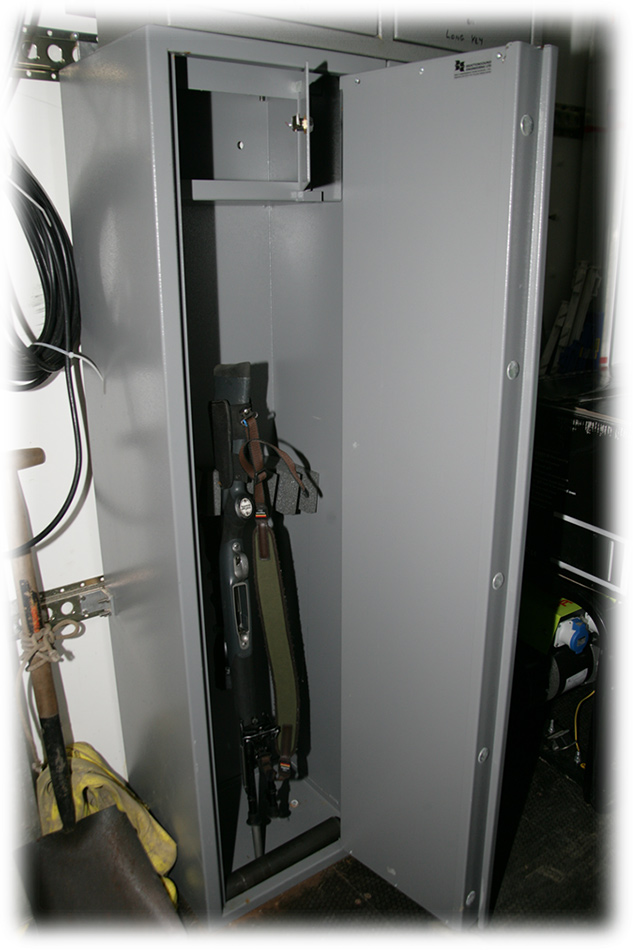
a security chain is anchored to a secure point in the vehicle using a locking device passing through the trigger mechanism
(inside the rifle case, the locking device passes through the trigger mechanism and secured to the vehicle)
Security, transport and storage
Introduction
The aim of this guide is to describe how to prevent, so far as reasonably practicable, access to firearms by unauthorised persons. It is written for rifles but the principles are applicable to all certificated firearms. It links to other guides in the Firearms series.
Security
Security of your firearms and ammunition is your responsibility.
- Ensure that you are in possession of a valid Firearms Certificate (FAC) which covers all firearms and ammunition in your possession.
- Ensure firearms and ammunition are stored in accordance with the conditions of your FAC.
- Only allow individuals authorised to possess your firearm to have access to it.
- Keep your FAC safe and ensure that you can produce it if requested by the An Garda Siochana, when carrying your firearms.
Methods of securing firearms
The Firearms (Secure Accommodation) Regulations 2009 specify the conditions for storage of firearms. These conditions vary depending on the number and type of firearms held by the FAC holder. The onus is on the owner of the firearm to know the law. For further information contact your local Garda Superintendent. Detailed guidance is available on www.garda.ie¹
- Where required any cabinets used for storing firearms or component parts should conform to British Standard 7558.
- Keep keys in a safe location known only to the FAC holder.
- When in shared storage, secure individual firearms by removal and retention of the bolt and lock with a trigger lock or other security device to prevent unauthorised access to your firearm by others.
- When staying in a hotel or guesthouse, firearms may be stored in a safe or in a cabinet on the premises to which only you have access. If this is not available, then use a security chain anchored to a secure point.
- Ensure the rifle bolt is secured separately from the firearm itself.

the security chain should be anchored to a secure point in the vehicle, and the firearm kept out of sight
Ammunition
- Ensure that ammunition is stored and transported securely to prevent unauthorised access. It should be stored separately from the firearm. In secure storage it should be either within a separate secure compartment in the gun cabinet, or other locked container. In other situations it could, for instance, be locked in the glove compartment of a vehicle.

gun cupboard fitted with separate lockable compartment
Storage conditions
- Due to their unlined steel construction, gun cabinets are not the best environment for rust protection of firearms. To protect firearms from rust, install the cabinet in a warm area of the property and add damp absorption bags.
- Ensure that rifles are dry, clean and lightly oiled prior to being put in a cabinet (see Maintenance guide”).
- For long-term storage of firearms, make sure that they are clean, and then oil the bores and metalwork. Make sure that all oil in the bore is removed prior to use.
- Sound moderators and muzzle brakes should be removed and lightly oiled before storage. This is to maintain condition of the moderator, prevent adhesion to the barrel threading and to prevent rusting damage to the crown and barrel.
- If possible, when storing firearms for long periods, place them in the cabinet barrel downwards, as this stops oil in the bore and mechanism from draining into the head of the stock, thereby potentially rotting wooden stocks.
- Check stored firearms occasionally, to ensure that they are not rusting.
Transport
General
- If you suspect that the rifle may have been jolted or damaged during transport check it before using and check accuracy before shooting at a live target.
- Use robust containers that provide security and protection.
- Consider insuring your firearms against loss or damage.
Vehicle
- Ensure that firearms are in a suitable container, preferably secured to the vehicle.
- When stopping to refuel etc, make sure the vehicle is locked, firearms are secured to the vehicle out of sight, and take the bolt and FAC with you. If possible park the vehicle in a well lit space and where you can keep an eye on it.
Visitor’s permits
- If you intend to take firearms to another EU Country, ensure you have a European Firearms Pass, available from your Firearms Licensing Office. Visitors to the Republic of Ireland require a Visitor’s Firearm Permit.
Air, sea, rail
Transport providers may require much longer to check-in with a firearm, if they accept them at all.
- Check with the transport provider at the time of booking the requirements for Firearms and Ammunition transportation, including relevant paperwork and insurance.
Further Info
http://garda.ie/Documents
[printfriendly]